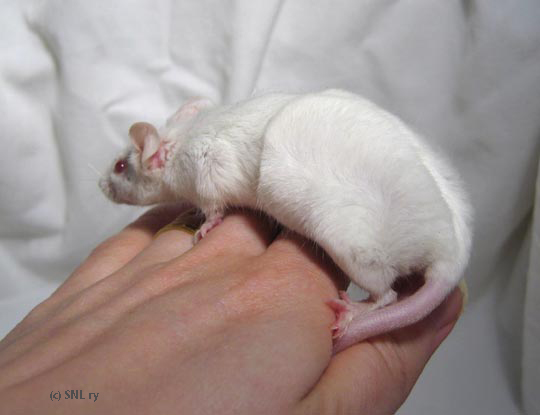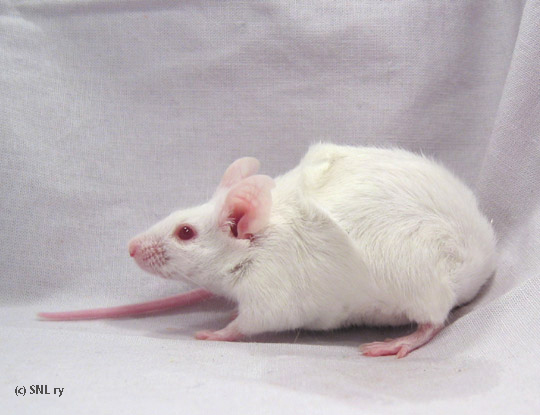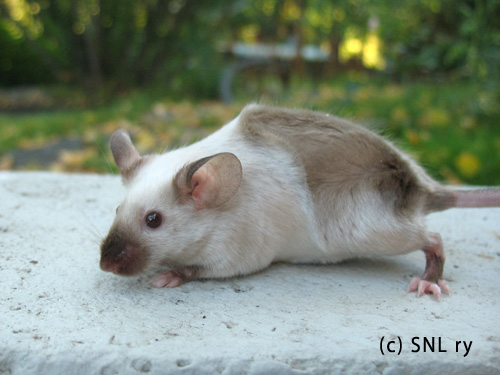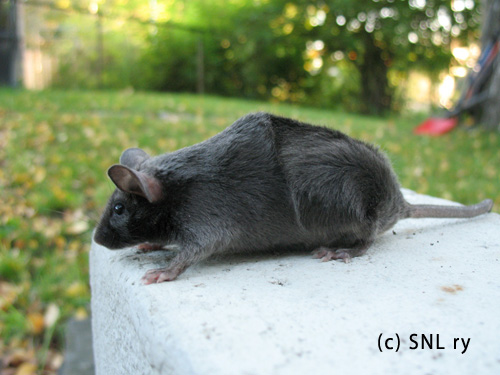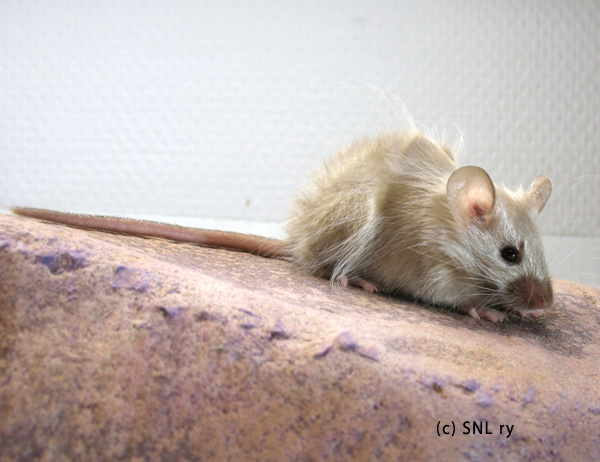Varieties
Coats
Abyssinian (ab)
(short hair abyssinian = sh ab, long hair abyssinian = lh ab, etc)
rst/rst
"Coat has rosettes and ridges, which are to be well defined and symmetrical. There should be, at minimum, rosettes on both sides of the rump and on the belly, and a ridge across the back. More rosettes considered as extra merit. The overall impression should be balanced. Rosettes and ridges may lose some of their distinctiveness with age."
Breeding information below the pictures.
Text: Anniina Tuura
Quick Look
An Abyssinian mouse has similar rosettes and ridges in its coat as does the Abyssinian cavy. This variety showed up as a spontaneous mutation in the late 1960’s in a stock of British fancy mice. Abyssinians were imported to Finland from Germany in 2004. This variety of mice is called "rosetted" in many other countries.
A good Abyssinian mouse looks quite extraordinary with its rosettes and ridges. This coat variety is however difficult to breed, which is probably the reason it hasn’t become popular in the fancy anywhere. Abyssinian mice are quite rare in Finland, so anyone seeking one as a pet may have to wait a good while, and settle for one with modest coat quality.
Genetic Background
The chromosomal location of the rosetted gene is yet unknown. The gene is marked with abbreviation rst. The variety is recessive: the gene has to be inherited from both parents and the rosettes show in homozygous rst/rst animals. However, in practice, the way the rosetted coat is inherited is somewhat more complicated compared with most other recessive coat or colour mutations.
If we take longhaired mice as an example; they can be bred to shorthair, and these longhair gene carriers in turn can be mated together and some of the offspring will be clearly longhair (sometimes even really good longhairs). Rosetted doesn’t work this way. There are, most likely, some kind of accumulative modifiers at play, which means that an outcross to non-Abyssinian will ‘reset’ these modifiers, destroying the quality of the coat. Getting the same quality back may require Abyssinian to Abyssinian matings for several consecutive generations.
Mating two gene carriers (from shorthair outcross) together usually produces rosetted offspring that only have the belly rosette and, at best, very poorly defined rosettes on one or both sides of the rump, which may then entirely disappear with age. As result of these genetic traits, breeding rosetted mice may require quite strict inbreeding. Breeding Abyssinians could be compared to breeding marked varieties; only the marking is in the coat itself and not the colour. As inbreeding will quickly multiply any faults in the line, thorough consideration should be paid when using mice with any unwanted qualities for breeding.
Breeding
The Finnish show standard doesn’t set very specific requirements for the rosettes and ridges of Abyssinians. The goal for breeding could be described as a mouse with an impressive and symmetrical coat. This can be achieved with the minimum amount of rosettes set in the standard, given that they are nicely placed and form sharp ridges.
The belly rosette should be clear and as long as possible. Dorsal hair will form at least one transverse ridge, the specific location may vary, but with the minimum number of rosettes this ridge would preferably be set in the middle back. The transverse ridge doesn’t have to be straight as long as it’s symmetrical – if the mouse has shoulder rosettes, this ridge will trace their edges. There may even be two transverse ridges depending on the number and location of rosettes. In most cases a longitudinal ridge will also form on the back, this must be straight. A whorl of hair often resembling a small crest of a wave may form at the crossing between the transverse and longitudinal ridges, this shouldn’t be considered a fault.
Poorly defined rosettes and/or ridges are the most common faults. These can be corrected by breeding Abyssinian to Abyssinian for several consecutive generations, always excluding animals with poor coats from further breeding. A longitudinal ridge that falls on either side of the back is a fault that is quite strongly inherited and should be eliminated from the line.
The more generations of Abyssinian to Abyssinian matings have been made, the more rosettes will usually develop. This doesn’t guarantee better animals though, because additional rosettes are often formed asymmetrically or cause asymmetry in the ridges. Increased challenge in breeding this variety thus goes hand in hand with increased number of rosettes.
The ridges are visible on Abyssinian babies as soon as the first coat starts to develop. Rosettes and ridges show well in their first coats and are a reliable indication of what the potential of their adult coats is. As the babies reach 2-3 weeks, they will lose most of the clarity of their ridges and rosettes. This phase is only transient and good Abyssinians will get their well defined coats back by the age of 5-6 weeks. The ones with less quality will not regain their coat quality, and the coats won’t improve after this age. By the age the mice are ready to leave for their new homes, the breeder can see their coat quality clearly.
Sooner or later the breeder will need to outcross to a sh or shs mouse in order to improve the type of Abyssinians. The best option is to select a male that is as big as possible, with good type and large ears, and breed this male to a number of Abyssinian females. The offspring, which will be rosetted gene carriers, can then be bred back to Abyssinians. With any luck, these litters may already produce some show quality Abyssinians. Carrier mice can also be bred together, but in such case getting the coat quality back will take longer.
All other hair types can be combined with rosetted. Satin Abyssinian is a very beautiful variety and Abyssinians can be bred as both non-satin and satin in the same line. Longhaired Abyssinians are nice looking when they are young, but as they will lose some of both the length of their hair and the sharpness of their ridges with age, adult animals look more modest. To combine astrex or fuzzy with Abyssinian intentionally is not a very good idea: the rosettes and ridges of an Abyssinian show poorly in curly coat, and for this reason these coat combinations are not judged in standard classes in Finland.

